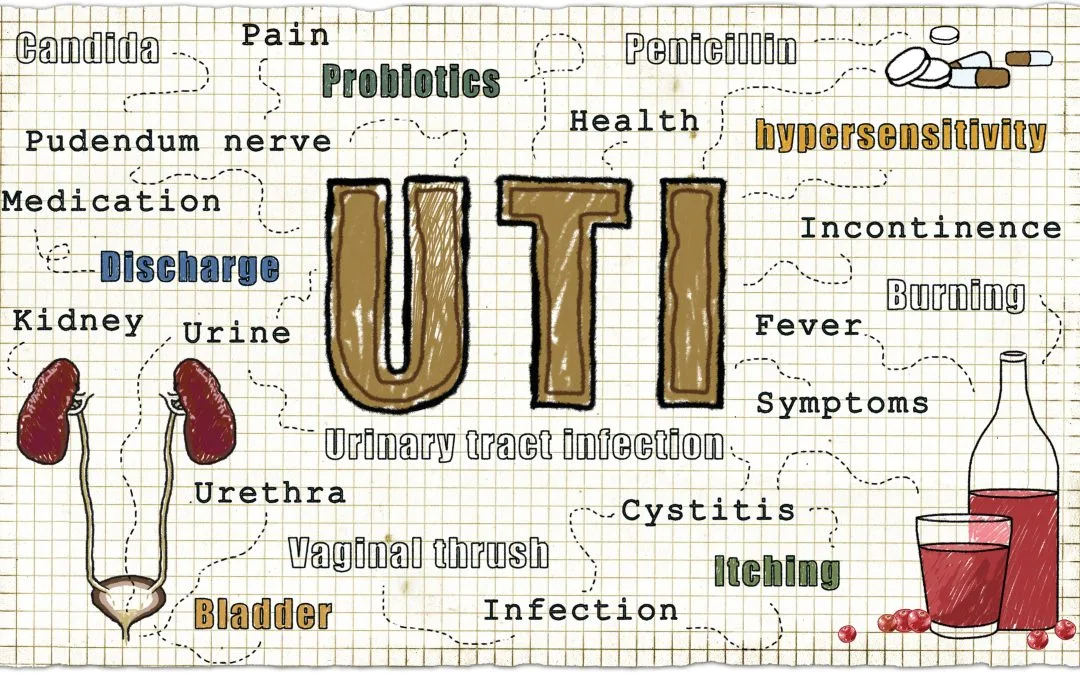
Why Do I Keep Getting Urinary Tract Infections?
Your long-awaited family vacation is finally here and tops on the list is a scenic helicopter tour in one of your favorite areas. The only problem is you have suddenly found yourself with a near-constant urge to use the restroom, which promises to be a huge problem. Our bodies provide clues when things just aren’t right, and it’s up to us to pay attention and figure out what they might be communicating.
What Causes UTIs?
That burning sensation you felt while urinating and the mystery pain in your lower abdomen led to the diagnosis of a urinary tract infection (UTI) and if you are a woman it may not have been your first one.
The urinary tract is the body’s drainage system. It removes waste— extra fluid, toxins, and salt that the kidneys filter from the bloodstream in the form of urine. The kidneys connect to the bladder by the ureters which are thin muscle-like tubes. At the bottom of the bladder is the urethra which carries urine from the bladder and out of the body. Urinary tract infections occur when bacteria, usually Uropathogenic Escherichia coli (E. coli), overtake part of the urinary tract. The bacterium typically enters through the urethra and travels up to the bladder. Once the body recognizes the bacterium, the infection is expelled into the urine. It is still a research question as to why mild infections clear up easily with antibiotics and why those who experience severe infections tend to experience chronic infections.
An answer to the question may have to do with genetic modifications in cells that occur as the result of an infection and over which a person has no control. Severe UTIs cause a change related to DNA markers in urinary tract cells affecting the reading of the DNA sequence. This change promotes more aggressive reactions with consecutive infections. It is not known if these DNA modifications can revert after a period of non-infection.
Who can get a UTI?
Only 10% of men get UTIs as compared to about 60% of women. Men are less likely to get urinary tract infections because their urethra is longer making it more difficult for bacteria to reach the bladder. UTI risk factors for men include an enlarged prostrate and a history of urinary tract abnormalities. When men get UTIs the infection is more likely to spread to the kidneys and upper urinary tract making UTIs more complex to treat. Anyone can get UTIs from medical procedures such as catheter insertion or cystoscope insertion or due to backflow from the bladder when the bladder gets too full or does not fully empty causing urine to back up into the ureters.
In a woman’s anatomy, not only is the urethra much shorter, but it is near the anus which harbors E. coli bacteria increasing a woman’s risk of infection. One in three women has had a urinary tract infection requiring antibiotics before the age of twenty-four.
Additional UTI considerations for women:
Sexual intercourse: UTI bacteria-causing bacteria can pass between partners. The friction and pressure associated with intercourse can force genital area bacteria into the urethra and up to the bladder increasing the chances of infection. Frequent intercourse or a new partner can both increase your risk of UTIs.
Contraceptives: Spermicides can impact the likelihood of you getting a UTI as they may kill off the bacteria that protects the vagina from bacterial colonization, Lactobacilli.
Hygiene: not wiping properly (front to back) after using the restroom, douching and using other feminine hygiene sprays, and not frequently changing your tampon or pad during your period, bath oils, and vaginal creams.
Genetics: There is a link between a woman’s first-degree relatives (parent, sister, child) having had more than five UTIs which means an increased risk for her.
Age: As women age and after menopause, bladder contractions tend to weaken making complete voiding more challenging.
When a person has had at least two infections within six months or three infections in a year, they have recurring UTIs or RUTIs. 1 in 4 women gets RUTIs and 25% to 30% have a UTI recurrence within 6 months. Doctors treat RUTIs with regular low-dose antibiotics.
Common Causes of UTIs
- An immune disorder
- Diabetes which creates extra bacteria as it breeds in sugar in the urine
- An anatomical issue preventing the bladder from fully emptying or a blockage such as kidney stones.
The most common complication of pregnancy is UTI infections with E. coli accounting for 80%-90% of them. There are risk factors involved such as preterm delivery, low infant birth weight, and miscarriage. Increased urine pH and decreased muscle tone in the pelvic region may also be factors. Pregnant women who experience RUTIs require prophylactic treatment. Penicillin and cephalosporins are safe for pregnant women.
UTIs in Children:
Children commonly experience UTIs, especially before the age of 5 with girls getting them most often likely because of anatomical differences. Uncircumcised boys are more at risk of UTI as is any child who with any sort of urinary tract blockage.
Be aware of irritability, crying, fussiness, vomiting, diarrhea, and poor feeding in babies. In children, incontinence (loss of urine control), trouble urinating, nausea and vomiting, lower back pain, and tiredness can all point to a UTI.
Common UTI Symptoms:
- Burning sensation when you urinate
- Needing to urinate more often at night than normal
- Lower stomach pain
- Cloudy, blood-tinged, or smelly urine
- Frequent and sudden urge to urinate with only a small amount produced
- Full-feeling bladder after urinating
- Lower back pain
- A low temperature under 96.8 °F
- Some people have no symptoms at all
UTI Testing
Urine testing: or urinalysis is when a lab tests urine for red blood cells, white blood cells, bacteria, protein, and signs of infection while also testing to determine which bacteria is causing the infection.
Kidney ultrasound: sound waves and a computer make images of blood vessels, tissues, and organs showing internal organs as they function and assessing blood flow through vessels. (A boy with a UTI or a girl younger than age 5 or 6 may need this test.)
Voiding cystourethrogram (VCUG): A type of X-ray where the bladder is filled with a liquid dye. X-ray images show the bladder as it fills and empties revealing any reverse flow of urine into the ureters and kidneys.
Antibiotics such as ampicillin, amoxicillin, and sulfonamides are no longer the drugs of choice for UTI treatment because of the widespread E. coli antibiotic resistance (15–20%) in areas of the USA and other countries. There is a non-antibiotic therapy available that stimulates the production of antibodies which can lower the occurrence and severity of UTIs.
Sepsis: A Serious UTI Complication
Sepsis is the body’s response to an infection which triggers a chain reaction that when untreated leads to tissue damage, organ failure, and death. Most cases of sepsis begin before hospitalization and 25% of sepsis cases originate from bacterial infections of the urogenital tract. It is especially important to consult with a doctor if you suspect you or a child may have a UTI.
Those most at risk for sepsis:
- Children under 1 year old
- Over 65 years old
- With a compromised immune system
- Have had a recent severe illness and/or hospitalization
- Suffering from chronic medical conditions
- Former sepsis survivors
UTI Symptom Management
- Drink water: Drinking plenty of water can help flush out bacteria from the urinary tract, reducing the severity of UTI symptoms.
- Take over-the-counter pain relievers: Over-the-counter pain relievers such as ibuprofen and acetaminophen can help alleviate pain and discomfort caused by UTIs.
- Apply a heating pad: Applying a heating pad to the lower abdomen can help relieve the pain and discomfort associated with UTIs.
- Use urinary tract analgesics: Urinary tract analgesics such as phenazopyridine can help relieve the pain, burning, and urgency associated with UTIs.
- Avoid irritants: Avoiding caffeine, alcohol, spicy foods, and acidic foods can help reduce the severity of UTI symptoms. These irritants can build up in the urine, making urinating even more painful while you have a UTI.
- Recent studies have shown that cranberry juice has a negligible effect on UTIs and is no longer recommended. Green tea has anti-inflammatory and antibacterial properties that may help reduce inflammation resulting from infection, and d-Mannose is a promising antibiotic alternative to help prevent infection. Acupuncture has been shown to reduce the instances of cystitis (inflamed kidneys) in those prone by one-third. Probiotics are also considered helpful in maintaining a beneficial vaginal flora balance assisting in protection from UTIs.
Maintaining awareness of your body, or your child’s behavior is key in assessing when a doctor’s opinion should be sought. Through maintaining healthy habits and by securing timely medical intervention, UTIs can be avoided and, when needed, treated quickly and effectively.
Learn more about how to deal with your UTI by visiting AFC Urgent Care Arden today or walk into our clinic any day of the week!


